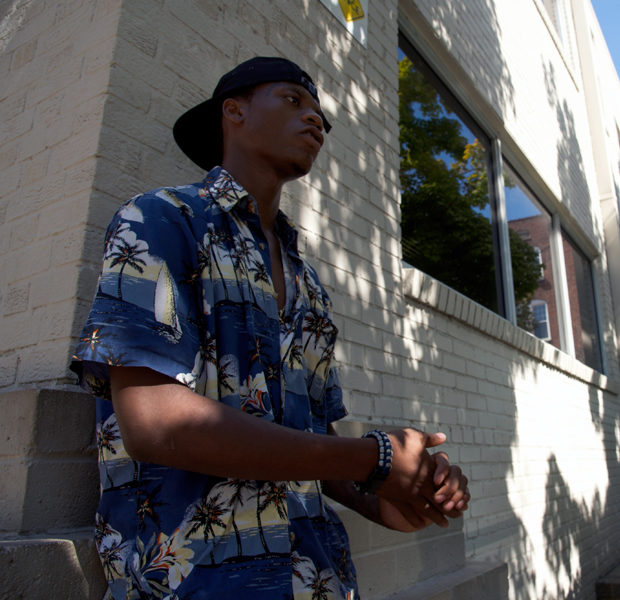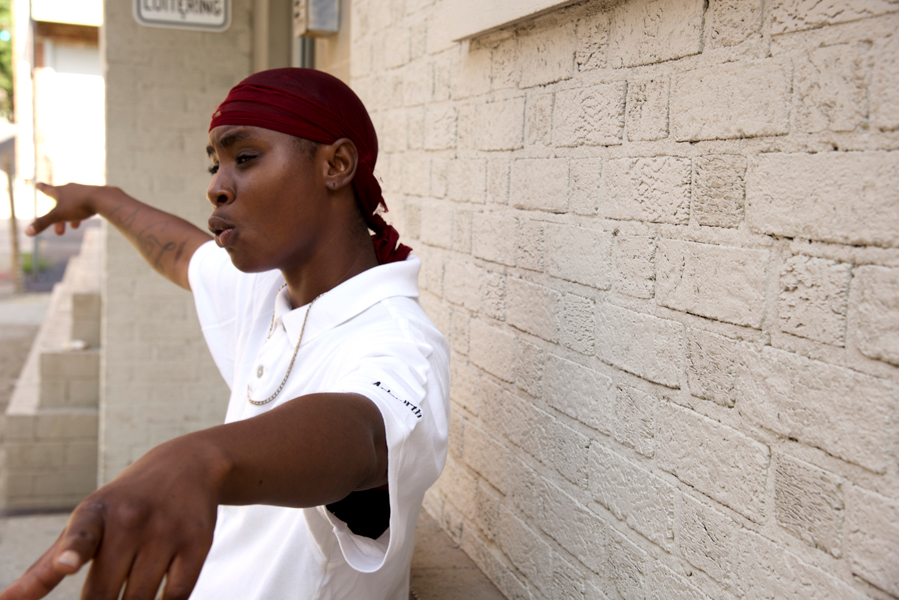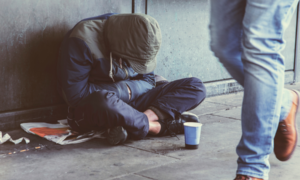
Photos by Roger Newton
Unique Glover, now 21 and in Charlotte, N.C., recounts how at 14 he got caught in the revolving door of homelessness and prison. He started stealing cars and robbing to make money so his two brothers and ailing mother could eat, he said.
Editor’s note: This article is the first in a series on homelessness and its intersection with youth justice.
Listen to an interview with reporter Tammy Joyner and the subject of her next story, George State University Sociology Chair Eric Wright, on GPB Atlanta 88.5 FM in the program “On Second Thought.”
I ain’t have jack but a black hat and knapsack
War scars, stolen cars and a blackjack
Drop that, and now you want me to rap and give?
Say somethin’ positive? Well positive ain’t where I live
I live right around the corner from West Hell
Two blocks from South Shit, and once in a jail cell
The sun never shone on my side of the street, see
And only once or twice a week I would speak
I walked alone, my state of mind was home sweet home…”
—From Naughty by Nature’s “Everything’s Gonna Be Alright”
They’re on our streets. In our schools and colleges. They’ve probably taken your fast-food order. But you wouldn’t know it.
They are society’s chameleons.
Nationally, 4.2 million young people between the ages of 13 and 25 are homeless during the course of a year, according to a 2017 study by Chapin Hall at the University of Chicago. The study is, to date, the most comprehensive look at youth homelessness in the nation.
Unlike their older and more chronically homeless peers, young people experiencing homelessness are not easy to spot or track.
They stay on the move, often traveling in “squads.” Some couch-surf or bunk together in extended-stay motels. Their life is in their backpack and cellphone. They’re more clean-cut, their conscious attempt to stay invisible.

Amy Louttit
“They try to blend in more with society because they’re trying to stay under the radar,” said Amy Louttit, public policy associate at the National Network for Youth in Washington, D.C.
Trying to live within the boundaries of the law however, often clashes with surviving the streets, experts say. Having to go to the bathroom in public. Lifting a bag of Cheetos from a convenience store to dull the hunger. Sleeping on a park bench or in the doorway of a local business often can lead to a night in lockup or juvie.
Nearly 8 in 10 young homeless people interviewed said they had at least one interaction with police in the previous year, according to a 2016 study by the Family and Youth Services Bureau. Six in 10 youth in that study said they had been arrested. The study interviewed 656 youth in 11 cities.
“The fear of law enforcement is real for minors and young adults,” Louttit said. (She knows. She was homeless for about four years as a teenager nearly two decades ago. Today, she works with federal policymakers to ensure new laws regarding homelessness include input from young people who are homeless.)
Over the next 12 months, Youth Today reporters will look at programs in North Carolina, New York and Washington state that are helping homeless youth and young adults return to school or find jobs, as well as places to live, while steering clear of the justice system. Stories will center on young people who are thriving from such programs. The stories also will go beyond the numbers and policies. They will address concerns and issues advocates, experts, attorneys, government and law enforcement officials say are essential to eradicating youth homelessness, one of the nation’s toughest — and most hidden — challenges.
A new homeless generation
Homelessness is not a new issue but it has evolved into a more complicated problem.
The housing crash and the subsequent 2008 recession reshaped who is homeless in this country, experts say. Until then, single black men were most often considered the face of American homelessness, experts say.
After the recession, shelters began filling with families of all ethnic and economic backgrounds who had lost their homes. From there, the streets became home to thousands of children — many of them black, brown and gay — as family turmoil and a new round of drug crises — methadone, heroin and opioids — created a new generation of younger, more vulnerable homeless people.

Amber Graves bounced from foster care to homelessness to jail before finding help.
Amber Graves and Unique Glover are part of that new homeless generation.
Graves, a 20-year-old Bronx native who now lives in Charlotte, N.C., was left to raise her 1-year-old brother when she was 5 years old after their parents abandoned them.
“My main priority wasn’t a dollhouse. It wasn’t the race cars. No type of kid toys. It was making sure that me and my brother was safe and getting us out of this predicament,” said Graves, who bounced from foster care to homelessness to jail before finding help through The Relatives, a nonprofit crisis shelter that helps young people get back on their feet. The Relatives helped her find an apartment, get back in school and find a job. She is now between homes again.
“They’ve really been a great help,” Graves said.
Glover also found himself at the age of 13 thrust into the role of provider — for his mother and brothers. The church drummer ended up dropping out of school and giving up the church gig. It led to him doing “a lot of cons to get more money. I didn’t want to do those things.
“My mom didn’t have a job. She got sick. She couldn’t move her limbs. I had to get a job just to feed my family.”
By 14, he was homeless. The family got evicted. His mother and brothers bunked with another family. He chose the streets. He began stealing cars to get money “to feed my family.” That decision eventually landed him in prison.
“You still end up in prison even if you’re doing it for the right cause,” he said. His stint in prison was bruising.
“I felt nobody was there to help us,” said Glover, 21. “They’d throw us back in the street. We have no house, no clothes, no food, no money and now we have a record. Their plan is for us to go back out there, do more crime so they can bring us back in and they get paid.”
It wasn’t until he moved to Charlotte and became involved with The Relatives that Glover’s outlook changed.
“The Relatives has helped a lot. They talk to us. They give us mentors.”
Federal underfunding
One troubling trend among young people experiencing homelessness: Adolescent boys are being turned away from shelters or public housing facilities even if they’re with their families.
“We see where boys have been put out so that the rest of the family can have a safe place to stay. Some of the rules of public housing limit the number of people who can live in the house,” said Trish Hobson, executive director of The Relatives.
Sometimes, Hobson says, staff has worked with a young man in the On Ramp program, which doesn’t offer shelter for those over 15. Consequently, she says, the next morning she’ll see the same young man sleeping in the organization’s doorway because he couldn’t find a place to stay.
“We’re just now getting data to really tell the story of homeless youth,” said Kelli King-Jackson, senior program officer at The Simmons Foundation, a nonprofit in Houston that works with groups working to end homelessness and other social problems. “The image before was a punk rock kid sleeping on the street in Seattle and that’s just not true.”
Nationally, programs geared to helping runaways and homeless youth are “incredibly underfunded,” according to Louttit.
“The runaway and homeless youth programs have not experienced the cuts in funding other federal programs have,” Louttit said. “[But] we’re still far under the authorized amount, which was $165 million under Obama. Congress hasn’t approved that amount yet but we’re at just over $120 million for the entire country. We’re incredibly underfunded.”
Consequently, it’s vital to pinpoint programs that are working and keeping homeless youth out of the juvenile justice system.
“Anytime we can connect young people with services as opposed to putting them in the penal system, that’s always preferred, especially when looking at young people experiencing homelessness,” said Naomi Smoot, executive director of the Coalition for Juvenile Justice in Washington, D.C. “Addressing those issues instead of criminalizing them is essential.”
Editor’s note: This article is made possible in part by support from the Park, Raikes and Tow foundations. Throughout this project, Youth Today will maintain editorial independence.































